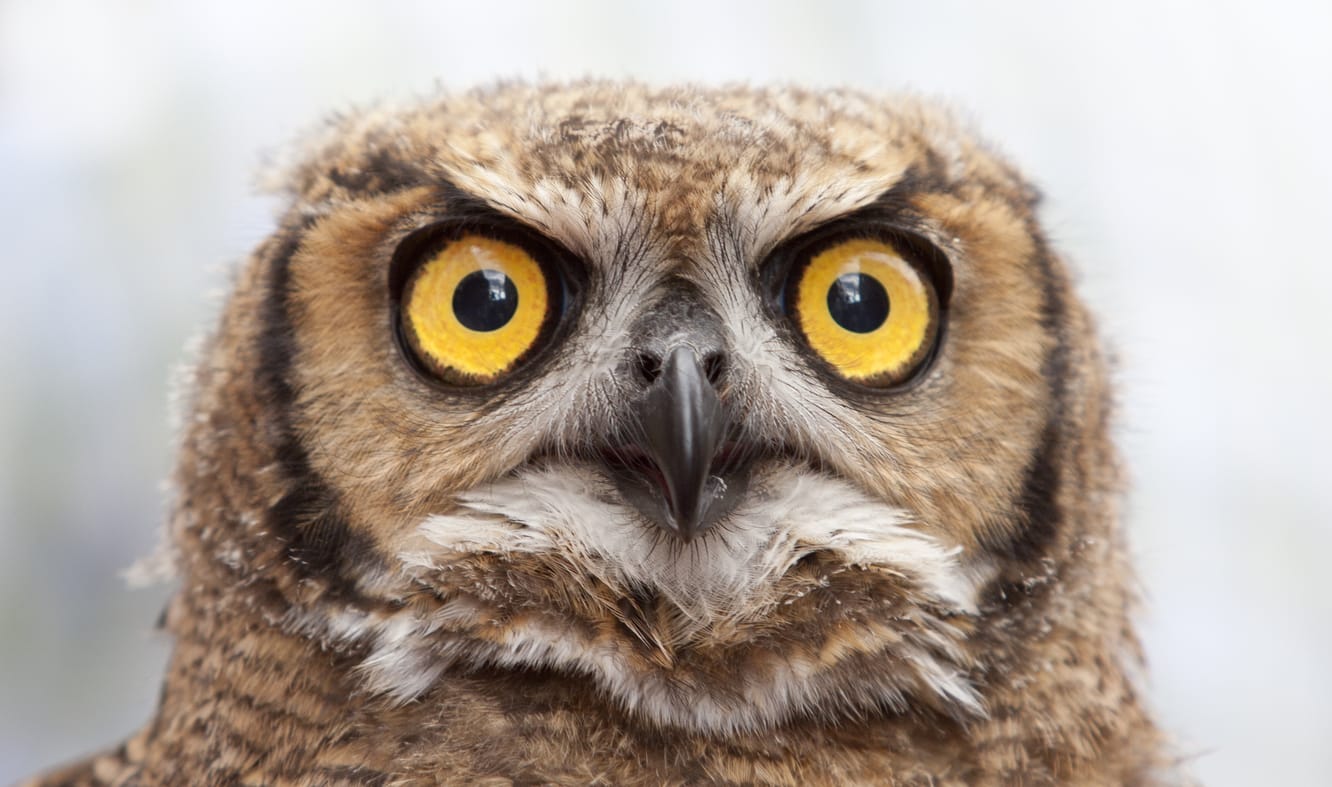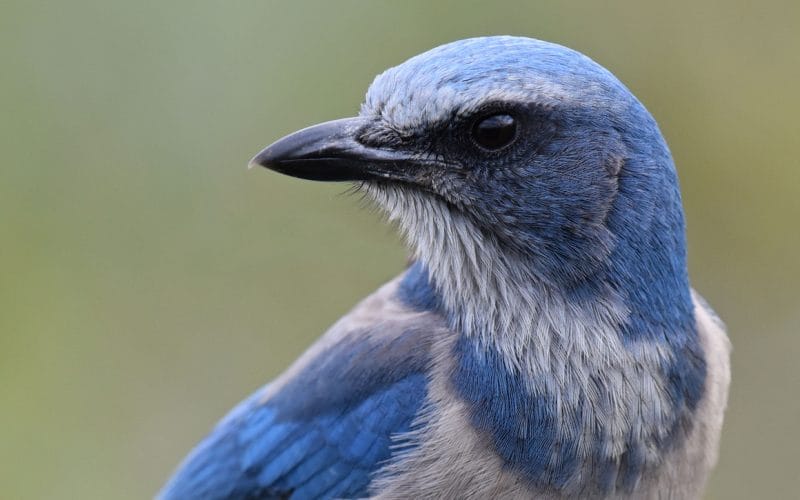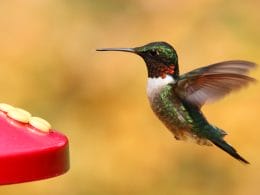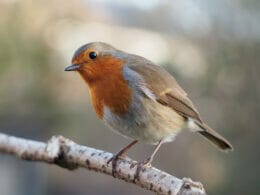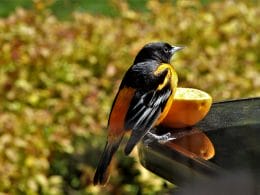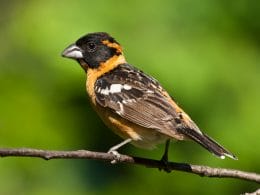Birds’ eyes are more varied than humans’, ranging from black to dark brown to white, yellow to orange to red, blue to green, and many shades in between.
Interestingly, the color of a bird’s eyes can vary depending on age, gender, adaptability, and even breeding season.
From the majestic Bald Eagle to the outlandish Yellow-eyed Penguin, this article lists 10 of the most unique birds with yellow eyes.
In addition to interesting facts and comprehensive descriptions of each species, this guide also shows you where you can spot these yellow-eyed birds!
10 Birds with Yellow Eyes
The following is a list of 10 bird species that have had yellow eyes at some point in their lives, whether as chicks or adults.
1. The Great Egret

- Scientific name: Ardea alba
- Length: 37 to 40.9 inches
- Weight: 35.3 ounces
- Wingspan: 51.6 to 57.1 inches
The elegant Great Egret is a yellow-eyed, long-legged white heron with long S-curved necks that can be found all over the world.
Author Note: Its plumage is pristinely white all over, with yellowish-orange bills and gray to sooty black legs.
During the breeding season, both male and female Great Egrets grow long, flowing plumes called aigrettes from their backs that curl over their tails, which is where the name Egret comes from. They also develop a lime green patch from their eyes to their bills.
You can’t rely on a Great Egret’s plumage to separate it from other egrets, though. Its large size and long, sooty black legs are what sets the heron apart.
You can spot this dazzling bird in both fresh and salt shallow wetlands as far north as Massachusetts, but it’s most common in the southern United States.
Great Egrets hunt while wading, so they’re often seen in ponds, marshes, and tidal mudflats. They will stand still until prey approaches, then jab their dagger-like bills into the water with startling speed to catch their prey.
Those swift hunters mostly feed on fish, but they also hunt amphibians and small aquatic insects. They may hunt grasshoppers and rodents in open fields.
2. Redhead Duck
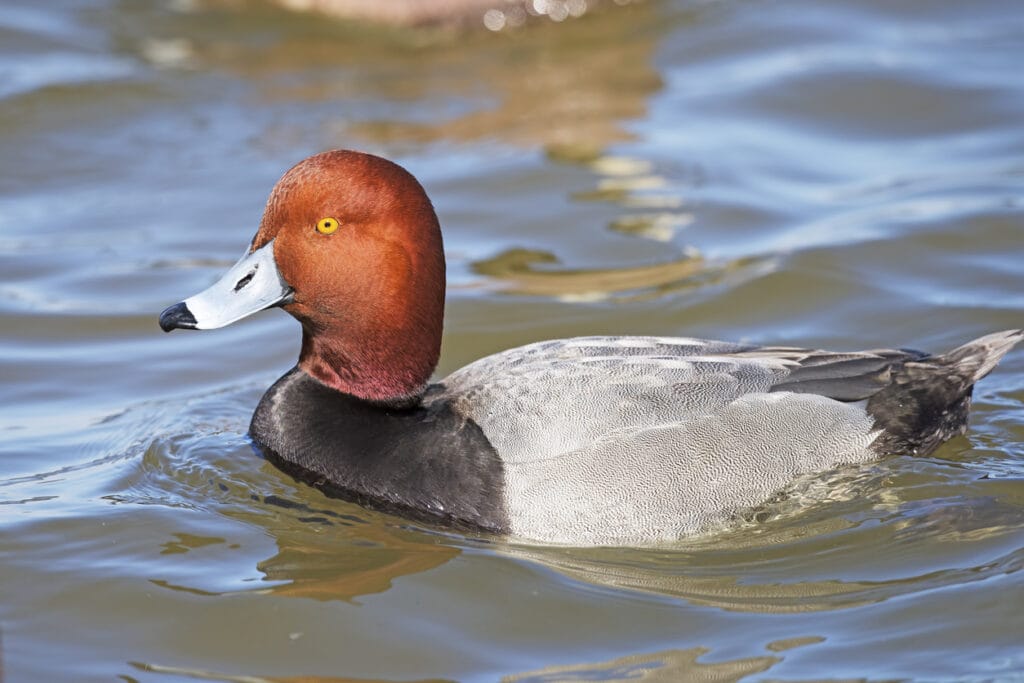
- Scientific name: Aythya americana
- Length: 16.5 to 21.3 inches
- Weight: 22.2 to 52.9 ounces
- Wingspan: 29.5 to 31.1 inches
The Redhead is a gregarious diving duck that’s present year-round in Mexico’s central volcanic belt.
During the breeding season, winter, and migration, most Redheads congregate in large flocks along the Gulf Coast. Others can be found in lakes, reservoirs, bays, and along coastlines in southwest Canada and the Lower 48.
Redheads, like all pochards, feed on both plant and animal materials. When breeding and wintering, these redheads feed on insect larvae, gastropods, and mollusks.
They do, however, shift to a mostly plant-based diet, consuming wild rice, muskgrass, and wild celery, among other plant materials.
Male Redheads have cinnamon-red heads, yellow eyes, and gray bodies, with black chests and rears. They have steep foreheads that meet the bills at an acute angle.
Female Redheads, on the other hand, have pale yellow eyes and are a duller-brown color all over, with a pale brown area around the base of the bill. They, too, have steep foreheads, but they abruptly transition into the bills.
The only physical similarities between male and female Redheads are their medium size, smoothly rounded heads, and blue-gray bills with black tips.
3. Lesser Scaup

- Scientific name: Aythya affinis
- Length: 15.3 to 18.1 inches
- Weight: 16 to 38.4 ounces
- Wingspan: 26.8 to 30.7 inches
Lesser Scaup, the most widespread diving duck in North America, is a medium-sized diving duck that’s known for its pale gray-blue bill.
Lesser Scaup males have piercing yellow irises that are surrounded by a black head with an iridescent purple sheen. Their bodies are white, with black-and-white backs and glossy black chests and rears.
On the other hand, females’ eyes tend to change from olive-brown to olive to brownish-yellow. Their plumage is brown overall, but their heads are a darker brown. Some female Scaups may have a white patch around the base of their bills.
Fun fact: Lesser Scaups catch aquatic invertebrates by sticking their bill into muddy substrates and quickly opening and closing it while swimming forward.
Throughout the year, these diving duck species can be seen on lakes, wetlands, reservoirs, and along coastlines. If you see a dark mat of vegetation floating on a large body of water, you’re most likely looking at a flock of Lesser Scaups.
They flock together by the hundreds, if not the thousands, during the breeding season and winter in the prairie pothole region in the US and the north of Canada in the boreal forest and tundra zone.
4. Brown Thrasher

- Scientific name: Toxostoma rufum
- Length: 9.1 to 11.8 inches
- Weight: 2.1 to 3.1 ounces
- Wingspan: 11.4 to 12.6 inches
Brown Thrashers are large songbirds with long legs, bills, and tails. Both males and females have staring yellow eyes and a foxy-red brown plumage, with black streaking on the underside and black-and-white wing bars.
These elusive birds are most common in eastern North America, but they’re difficult to spot. They spend most of their time in dense covers, such as scrubby fields, forest edges, thickets, shrubberies, and thorn scrubs.
They can, however, be heard while foraging for food on the ground. They may also appear in your backyard if you have a bird feeder or berry-producing shrubs.
Their diet mainly consists of insects and arthropods, but they often eat berries, small fruit, seeds, and nuts.
Keep in mind that while they’re fantastic singers, Brown Thrashers are known to attack any creature that may threaten their nests, including people and dogs.
5. Osprey
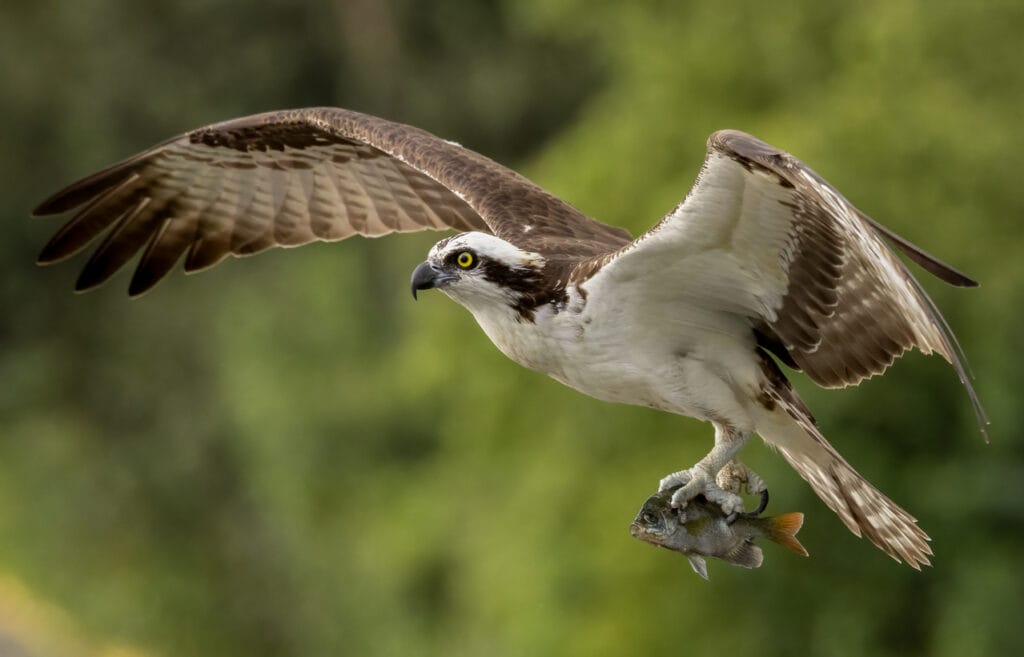
- Scientific name: Pandion haliaetus
- Length: 21.3 to 22.8 inches
- Weight: 49.4 to 70.5 ounces
- Wingspan: 59.1 to 70.9 inches
Ospreys are so unique that they have their own genus among raptors. It’s also one of the few species that can be found almost anywhere.
This yellow-eyed large bird of prey has a brown back and wings that contrast with its white underside. Its white head is most noticeable, with two broad brown lines extending from the eye to the neck.
Author Note: Because fish make up 99% of its diet, Ospreys can be found near any shallow, fish-filled body of water, such as rivers, swamps, lagoons, and lakes.
They’re also not afraid of humans, whether this is good news is up to you!
However, just so you know, Ospreys don’t mind building their nests from manmade structures. So, consider setting up a nesting box before the breeding season, which typically lasts from January to May.
6. Yellow-Eyed Junco
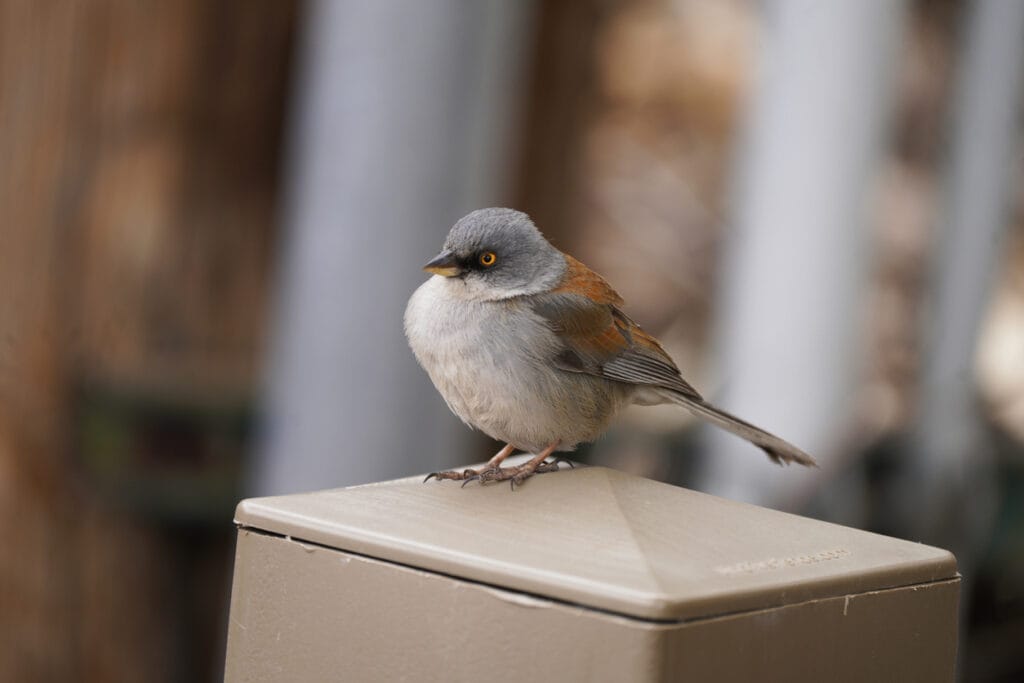
- Scientific name: Junco phaeonotus
- Length: 5.5 to 6.3 inches
- Weight: 0.6 to 0.8 ounces
- Wingspan: 9.4 to 9.8 inches
The Yellow-eyed Junco has, you guessed it, yellow eyes! Admittedly, their eyes are more of a bright yellow-orange color, but their sunlight-like gleam can help you instantly recognize these tiny New World sparrows.
Yellow-eyed Juncos are mostly bluish-gray in color, with a rusty red back and white tails. The undersides of Juncos from southern Arizona, New Mexico, south to northern Jalisco, and Mexico are whiter.
These tiny sparrows are indigenous to Mexico, but some flocks have relocated to Arizona and New Mexico’s mountains. They can be found in pine-oak and mixed coniferous forests at elevations ranging from 5,300 to 10,000 feet.
While they’re mostly sedentary, in the winter, Yellow-eyed Juncos migrate downhill to lower elevations, where they live in oak woodlands and fields.
7. Bald Eagle
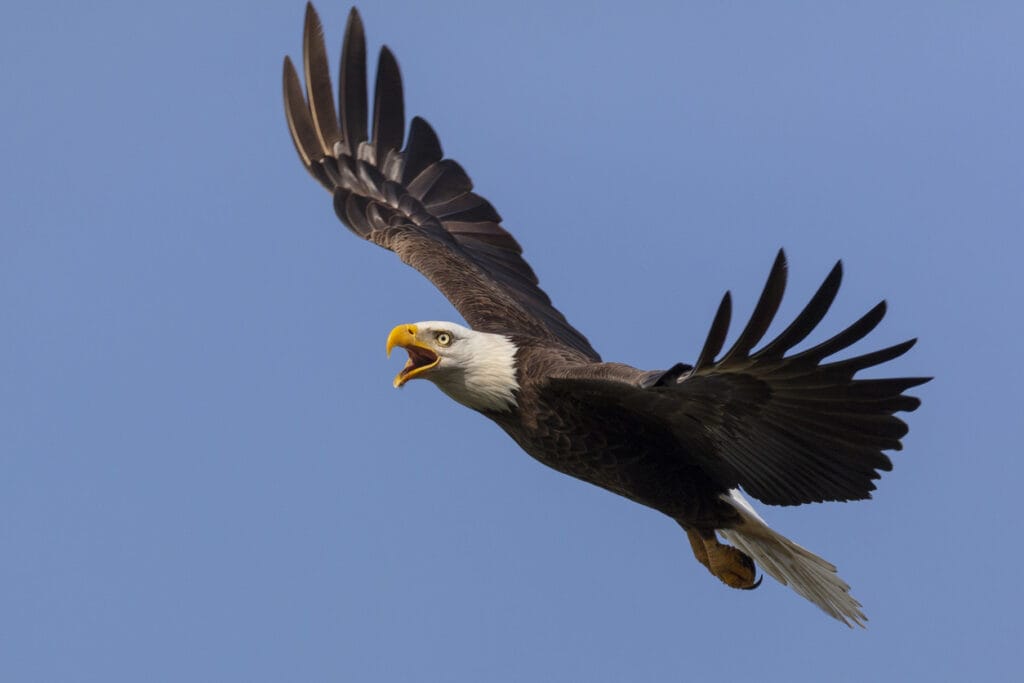
- Scientific name: Haliaeetus leucocephalus
- Length: 27.9 to 37.8 inches
- Weight: 105.8 to 222.2 ounces
- Wingspan: 80.3 inches
The Bald Eagle is the national symbol of the United States, and its largest population is found in Alaska. Its range, however, covers the entire continental United States, northern Mexico, and the majority of Canada.
These massive raptors prefer to live in forested areas near large bodies of water rather than in heavily developed areas. That’s why their diet mainly consists of fish of many kinds.
Regardless of whether the prey is live, fresh, or carrion, Bald Eagles feed on birds, rabbits, reptiles, invertebrates, turtles, and waterfowl.
Author Note: Like the Lesser Scaup, Bald Eagles have brown eyes as youngsters, but their eyes turn yellow as adults. They have heads and tails covered completely in white feathers that contrast their brown bodies.
8. Ring-Billed Gull
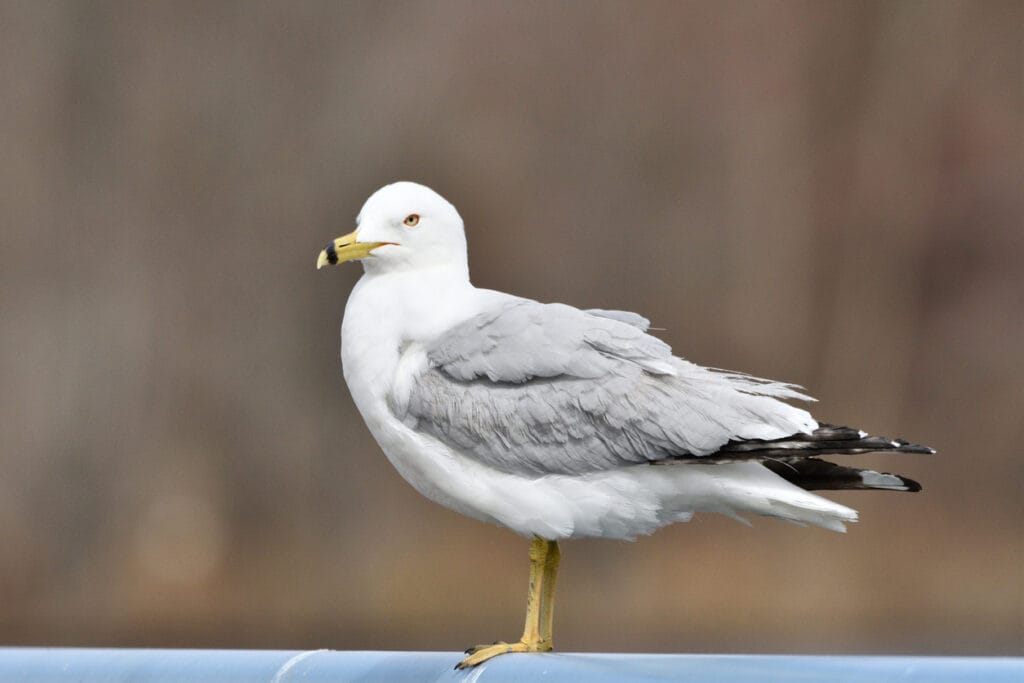
- Scientific name: Larus delawarensis
- Length: 16.9 to 21.3 inches
- Weight: 10.6 to 24.7 ounces
- Wingspan: 41.3 to 46.1 inches
The Ring-billed Gull can be found farther inland than most other gull species. It’s one of the few bird species that has fully adapted to human civilization. They can be seen in urban, suburban, and agricultural areas as well as beaches, docks, and mudflats.
You can often see huge flocks of Ring-billed Gulls resting in parking lots, at sporting events, and especially near fast-food restaurants.
These seabirds earned themselves the nickname “fast food” gulls because they’re aggressive and opportunistic omnivores that feed on everything from fish to fruit to garbage to roadkill.
Ring-billed gulls are another bird species that change eye color with age, from brown to yellow. They also have yellow legs and bills, with a black band across the tip of their bills.
Aside from the pale gray back and dark tail, their plumage is mostly pure white.
9. Common Goldeneye
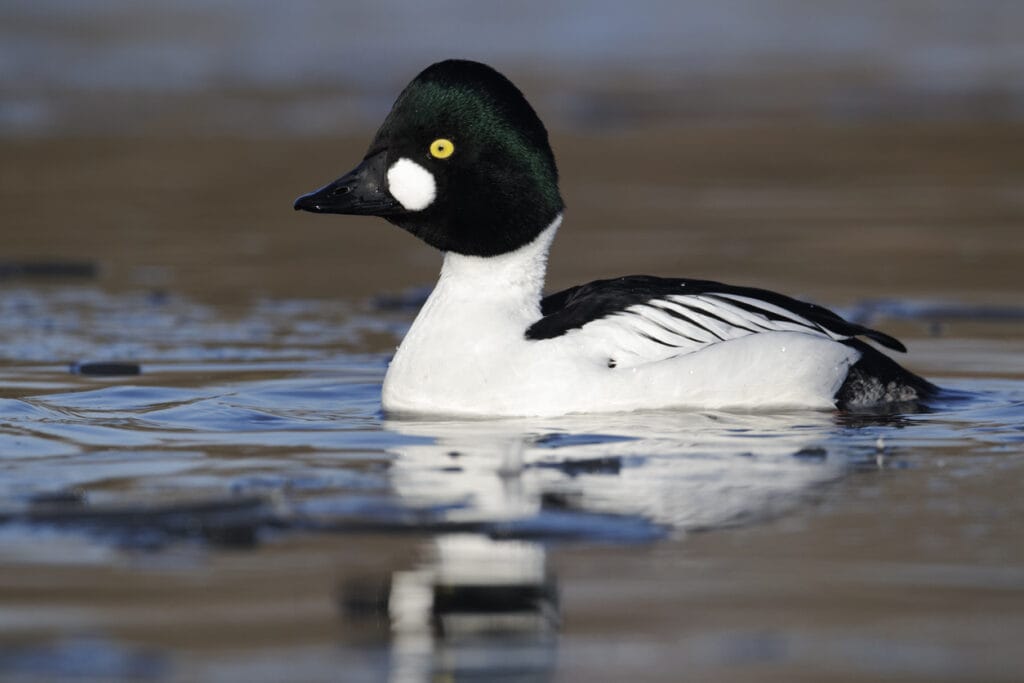
- Scientific name: Bucephala clangula
- Length: 15.8 to 20.1 inches
- Weight: 21.2 to 45.9 ounces
- Wingspan: 30.3 to 32.7 inches
The Common Goldeneye is a cold-hardy diving duck that mainly breeds in the Canadian and Alaskan boreal forests. It’s also a winter resident in Missouri, so consider looking for this dazzling species in flocks on large bodies of water.
Male Goldeneyes are known for their distinct triangular, iridescent green heads with a round, white patch next to their all-black bills. Their bodies are mostly white with black backs.
Female Goldeneyes, however, have brown triangular heads and gray bodies. Their bills are also black, but the tips are yellow.
The eyes of Common Goldeneyes change color several times before settling on bright yellow in adult males and pale yellow to white in adult females.
Goldeneyes have gray-brown eyes when they hatch, then they change to purple-blue, blue, green-blue, and finally pale green-yellow by five months of age.
Common Goldeneyes have an exceptionally diverse diet; they feed on aquatic invertebrates, fish, and fish eggs. They’ll either forage in shallow waters or dive to a depth of fewer than 13 feet to catch crustaceans, mollusks, insects, and even seeds.
This voracious appetite may explain why Goldeneyes can be aggressive and overpower other duck species in a feeding area.
10. Yellow-Eyed Penguin
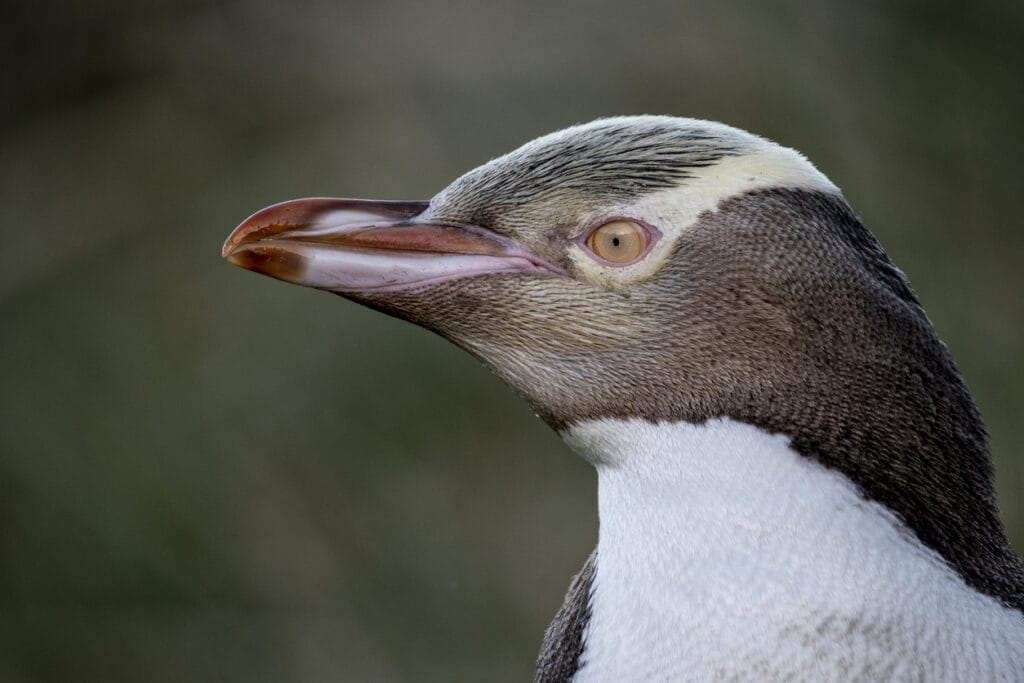
- Scientific name: Megadyptes antipodes
- Length: 22 to 31 inches
- Weight: 128 to 313.6 ounces
- Wingspan: not documented
One of the rarest penguin species in the world, the Yellow-eyed Penguin can only be found along New Zealand’s eastern and south-eastern coastlines.
The plumage of this one-of-a-kind penguin is multicolored. For starters, its pale yellow eyes are surrounded by a band of pale yellow feathers that encircle the back of the penguin’s head.
Its forehead, chin, and cheeks are black to slate gray flecked with yellow. The back and tail are slate blue, while the flippers’ undersides, chest, and belly are white.
Author Note: Much of the Yellow-eyed Penguins’ coastal forest habitat has been reduced to scrub remnants, but forests on other islands continue to be the dominant breeding habitat.
These magnificent-looking penguins feed primarily on red cod, blue cod, opal fish, squid, and sprat.
In Conclusion
While yellow isn’t always the most common eye color in birds, it does appear in a variety of species, ranging from ducks to penguins to raptors.
Some species have yellow eyes from birth, while others develop them later in life. Regardless, a bird’s piercing yellow eyes can reveal a lot about its age, species, gender, and so much more.
Luckily, though, it’s uncommon for birds with yellow eyes to be found only in one location. So grab your binoculars and head to your nearest birdwatching hotspot. You never know what kind of yellow eyes might be staring back at you!
FAQ
No they don’t. Birds of prey eyes range from yellow through brown and red. They can also be blue and gray.
There are a variety of reasons why the eye color of birds changes. These include hormones, aging, breeding and diet.
According to Pim Niesten, the nature filmmaker, says that owls with yellow eyes are active in the day, owls with orange eyes are active at dawn and dusk and those with black eyes are strictly nocturnal.




